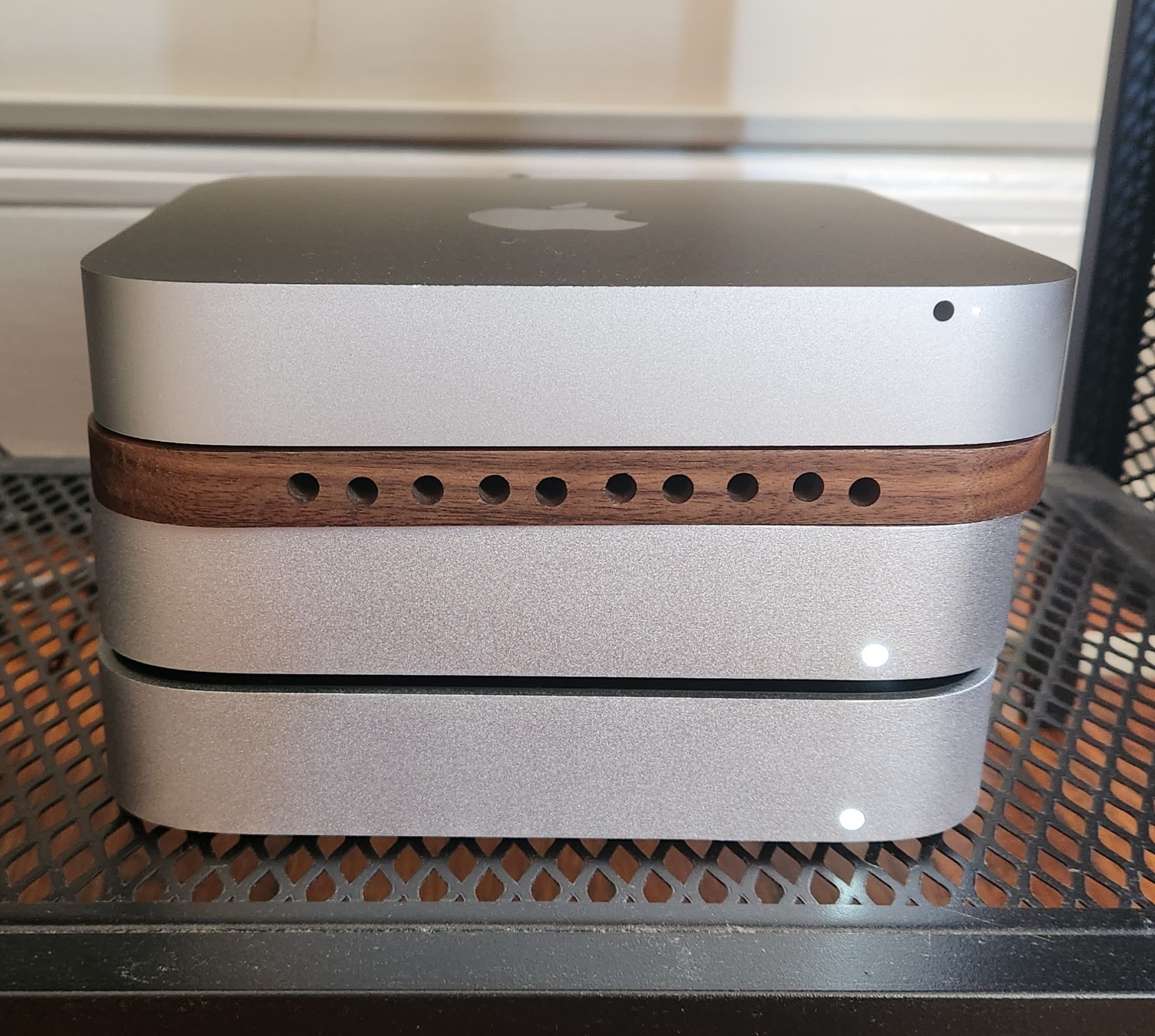The price seems pretty good. I don’t really know much about mini PCs. Do you think there is a better alternative?
Update: ok, not price efficient. Noted 👍
I’d recommend against it. Apple’s software ecosystem isn’t as friendly for self hosting anything, storage is difficult to add, ram impossible, and you’ll be beholden to macOS running things inside containers until the good folks at Asahi or some other coummity startup add partial linux support.
And yes, I’ve tried this route. I ran an m1 mac mini as a home server for a while (running jellyfin and some other containers). It pretty consistently ran into software bugs (less maintained than x64 software) and every time I wanted to do an update instead of sudo whateveryourdistroships update, and a reboot, it was an entire process involving an apple account, logging into the bare metal device, and then finally running their 15-60 minute long update. Perfectly fine and acceptable for home computing, but not exactly a good experience when you’re hosting a service.
You can get a Ryzen mini PC for less than $200. Depends on what is worth to you in cost.
If you’re hosting plex or jellyfin I’d recommend an old Intel processor with quicksync. I paid like 200 for my pc on ebay gutted it and put it in a bigger case for more hard drives. Runs 4k videos like a champ with no GPU installed.
What’s great about Mac minis is that they’re extremely power efficient since they’re ARM machines, so if you live somewhere like in Europe where power is expensive, it can save you a lot of money. They’re usually completely silent too.
Depending on their needs, I’d suggest OP to get a used M1 Mac mini, they’re great value for money.
You may want to check your specs again. The Ryzen APUs are very power efficient and run the same stretch as M3 (reported): 15W-45W
Though the more realistic at the wall measurements of the 2023 Mac Minis pretty much seem to have it pegged at a solid 15W-25W min under normal service workloads. The reported “idle” measurements of the M* chips being at 6W are literally just saying “if it has power”, and unrealistic considering you can’t even run them without a the GPU being engaged somewhat without a fully headless software configuration.
I would disagree with idle power not being important for a home server. Most of the time, your system will be doing very little and wait for something to happen. I also don’t think a typical server has a display attached. Wolfang explains this quite well: https://youtu.be/Ppo6C_JhDHM?t=94&si=zyjEKNX8yA51uNSf
I’m not saying idle power is unimportant. I’m saying the M-Class chips can’t ever go idle with a minimal set of features NOT being engaged, because they’re going to be more engaged in general vs other chips that can run truly headless. macOS doesn’t allow for that.
I don’t have one (and I don’t want one), but Anandtech measured the M1 version at 4.2W in idle. https://www.anandtech.com/show/16252/mac-mini-apple-m1-tested I think you can also get that from other Mini PCs (e.g. NUCs).
Cool, so the version from many years ago related to OP’s question…how?
It’s an Apple Silicon Mac Mini. Do you have a particular reason to think the new one is less efficient?
What’s great about Mac minis is that they’re extremely power efficient since they’re ARM machines, so if you live somewhere like in Europe where power is expensive, it can save you a lot of money.
I want to see numbers. How much is “a lot of money”?
I don’t have a Mac Mini, but for always-on systems, the idle power consumption can become quite significant.
- Gaming PCs can consume up to 100W (876 kWh / year).
- My AMD B650 NAS consumes about 17W in idle (150 kWh / year).
- A NUC / Mac Mini can idle as low as 5W (44 kWh / year).
If you pay 0.30$/kWh, running your old 100W gaming PC all the time would cost you 263$ per year. My NAS is 45$ per year…
It also depends on what you need/want from the machine. The Mac Mini doesn’t have any HDDs and can’t run a regular Linux distro, for example.
Would the Mac Mini actually idle at that wattage if it’s open for connections? I doubt it, it’s probably more like 10W, which is generally the range for those smaller AMD MiniPCs or NUCs.
If it’s 10W, that’s a $20 savings from your NAS w/ a desktop CPU (and probably a discrete GPU, unless it’s running an APU). I can get 4% easily on savings, so I’d only need a $500 savings vs the Mac Mini to recoup that difference every year ($500 * 4% = $20). So if you already have an old PC, use that instead of buying a Mac Mini, and you also won’t have to fight macOS to do what you want.
Cheap in Germany for example nowadays is 0,20 EUR / KWh + 15 EUR / month base fee. Most people have more expensive contracts though, 0,30 EUR / KWh and more
Fellow EU here. Those prices are crazy. My peak price is 0.18, while the valley is 0.08.
where is that in the EU…South-East parts?
deleted by creator
If it’s an older x86 model, just install Linux on it.
You can install Linux on ARM-based Macs too:
https://asahilinux.org/
[email protected]How well does that work though? My understanding is that there are still quite a few caveats, but it’s been a while since I actually looked into it.
Everything works except Thunderbolt/USB4 and Video output via USB-C
I wouldn’t use it as a NAS if you plan to use NVMe SSDs for fast storage (since you can’t connect them via USB4), but if you only plan on using SATA SSDs or mechanical drives, USB 3 should be fine. Other than that, everything you would need in a server is there and works flawlessly.
I switched all my server stuff to my m1 Mac mini because previously I was trying to host everything off my truenas scale NAS with truecharts. Since truecharts isn’t really an option for future truenas updates and I already had an m1 Mac mini I bought secondhand, I figured it’d work pretty well for docker containers, which it does. And it’s a ton more easy for me to troubleshoot than K8s.
Most answers here are missing the benefits of a home Mac running 24/7 if you’re already part of the Apple ecosystem. For example, you can have it sync all your iCloud data (documents, photos, iTunes content) and back them up locally, then elsewhere outside of Apple’s ecosystem. You can also have it act as a local CDN for OS updates, whereby it will cache OS downloads locally so any subsequent updates will be super quick.
On the downside, I found native Docker on macOS kinda sucked, and just installed Ubuntu on my 2012 Mac Mini (now running Proxmox for funsies), but I have an old iMac to do the caching. You could probably virtualize and get both benefits, and I am considering moving to a new M4 mini for the power savings and sheer speed. That M4 Pro chip has absolutely incredible Geekbench numbers while sipping power.
I have an old mac mini that was a server for a good 4-ish years.
The good:
- They are pretty good at sticking in a closet and forgetting about them.
- Specs are always on the decent side and some of the older models are easy to upgrade.
- Power is ok. It sips power
- It can run for years without issues. I still have two mac minis I used for CI/CD jobs, thin clients, etc…
- Its a cheap mac. If you need mac for something, like building custom mac specific applications, then its a decent little machine.
The bad:
- CPU is usually lacking compared to any computer of the same price range.
- MAC OS. Its good at desktop but as a server, it just doesn’t have the same options/ease of use as a good linux box. You can get around that by dual booting, but its just another headache. Docker/VMs are also an option, but the RAM/CPU usage would take a hit.
- The newer the model, the harder it is to upgrade.
I would use it as a specialty server if you have something you do automatically only macs can do. Or as a thin client/vm box.
I used to use it as a CI/CD box before github actions was a thing. If you happen to have one, sure set it up for fun. If you dont and are looking at buying one, I would suggest a cheap dell desktop or (depending on what you want to host) a pi 5 or thin client and throw linux on it.
It is very good but depend on what you want to host.
I have a second hand cheapest M2 with Asahi Linux and some container (like pihole) but not much. I like that it is small, silent and energy efficient (and it can run Xplane12 in 4k !). But I have an homemade NAS so most of the multimedia stuff and containers are on here and not on the MacMini.
The M4 seems incredible, but Asahi Linux only support M1 and 2 at the moment (it might work with M4 tho).
The problem with the mini would be disk space if you are looking for a NAS usage, although I have seen here on lemmy a dude making a Mac Mini NAS (can’t find the post anymore).

But even without Asahi, an M4 with Mac OS, docker and a VM if needed would be plenty of power for price and energy. You can also upgrade to a 10Gbe NIC if your network supports it. Plug it to some screens and you have a workstation + docker server in one place.
I bought a M1 Mac Mini second-hand and it’s great for home server purposes. Like others have said, you’ll be using containers a bunch, so bare metal doesn’t matter quite as much as it used to. They’re power efficient and offer good performance. If you’re in the Apple ecosystem, there’s a bunch of other benefits to having a Mac set up as a server (e.g. content caching for updates/iCloud content).
It’s fine, but not going to be the cheapest.
Cheap to buy: Any old PC desktop, really. Most will run linux and windows fine, depending on what you want. Anywhere from free to £100. If you have an old desktop or laptop already, use that to start with.
Cheap to run: Any mini PC. I run a Lenovo ThinkCentre M53 for low power duties. Cost £40 and runs silently at 10watts, idle. (I have a secondary, much beefier server for other stuff that runs at around 100w which lives in the garage)
But plenty of people do run mac minis as home servers, often on Linux. They’re fine - just do your homework on the CPU ability, how much ram you can add, and whether you’re okay with external disks if you can’t fit enough inside.



